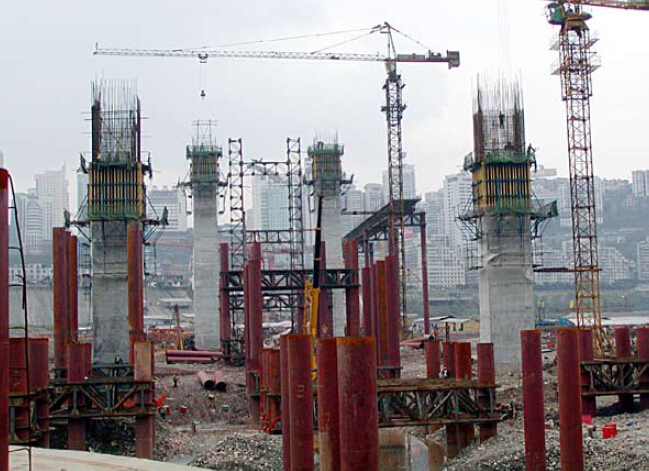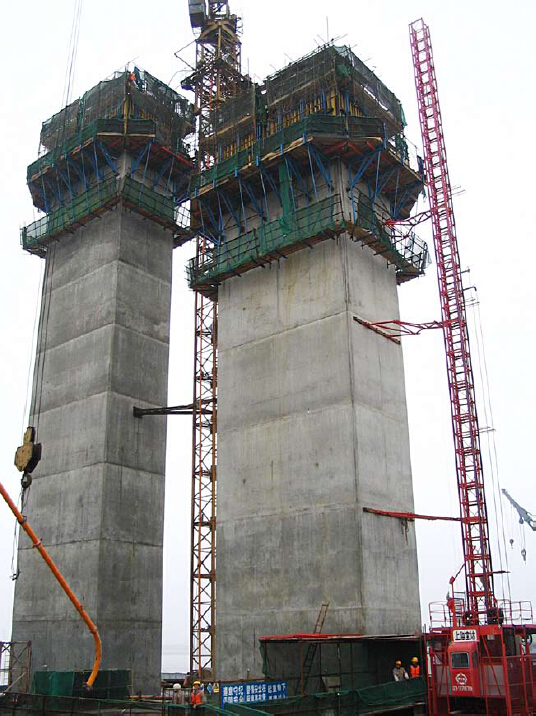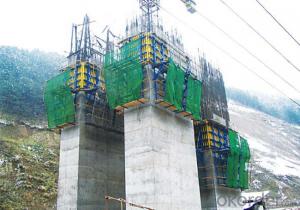Climbing-bracket CB-240 for formwork and scaffolding systems
- Loading Port:
- Tianjin
- Payment Terms:
- TT OR LC
- Min Order Qty:
- 50 m²
- Supply Capability:
- 1000 m²/month
OKorder Service Pledge
OKorder Financial Service
You Might Also Like
Climbing Bracket CB240 & CB210
They are framework brackets for supporting large-area wall formwork.
Typical applications for the CB240&CB210 are pier and column/shear wall/core walll/ in the
building.
CB210 has smaller size than CB240, it will be cost effective in some condition.
Characteristics:
◆ High bearing capacity
The high loading capacity of the brackets allow very large scaffold units. This saves the number
anchor points required as well as reducing climbing times.
◆ Simple moving procedure by crane
Through the strong connection of formwork together with the climbing scaffold, both can be moved
as a single climbing unit by crane. Thus valuable time-savings can be achieved.
◆ Fast striking process without a crane
With the retrusive set, large formwork elements can also be retracted quickly and a minimum of
effort.
◆ Safe with work platform
The platforms have assembled firmly with bracket and will be climbing together, without scaffolding
but can work safely in spite of your high location.


- Q:How does steel formwork handle different concrete slump loss over time?
- Steel formwork is highly durable and capable of effectively managing various degrees of concrete slump loss over time. Slump loss refers to the reduction in workability or consistency of concrete as a result of factors like evaporation, hydration, or temperature changes. One advantage of steel formwork is its ability to withstand high pressure and retain its shape, even when the concrete experiences slump loss. This is because steel formwork is rigid and offers robust reinforcement to the concrete structure. Unlike other types of formwork, such as wooden or plastic formwork, steel formwork does not easily warp or deform, even if the concrete becomes less fluid. Moreover, steel formwork is designed for reusability, enabling it to be easily dismantled and utilized for multiple construction projects. This is particularly advantageous when dealing with concrete slump loss over time. If the concrete slump decreases, the steel formwork can be easily adjusted or modified to accommodate changes in shape or dimensions. Furthermore, steel formwork delivers a smooth and uniform surface finish to the concrete structure. This is crucial because any imperfections or irregularities in the formwork can impact the final appearance and quality of the concrete. With steel formwork, the risk of surface defects or blemishes is minimized, regardless of any slump loss that may occur. In conclusion, steel formwork is well-suited for managing different degrees of concrete slump loss over time due to its durability, rigidity, and adjustability. It ensures that the concrete structure maintains its shape and integrity while providing a smooth and uniform surface finish.
- Q:What are the typical corrosion protection measures for steel formwork systems?
- Typical corrosion protection measures for steel formwork systems include the use of protective coatings such as galvanization or paint, regular cleaning and maintenance to remove any corrosive agents or debris, and the application of corrosion inhibitors or rust preventatives. Additionally, proper storage and handling practices, including keeping the formwork dry and protected from moisture, can also help prevent corrosion.
- Q:What are the considerations when designing steel formwork for architectural features?
- When designing steel formwork for architectural features, there are several considerations that need to be taken into account. Firstly, the formwork design should align with the desired aesthetic of the architectural feature, ensuring that it complements the overall design intent. Additionally, the formwork needs to be structurally sound and capable of supporting the weight and forces exerted by the concrete during pouring and curing. It is important to consider the ease of assembly and disassembly of the formwork to ensure efficiency in construction. Furthermore, the formwork design should allow for proper placement of reinforcement and any necessary inserts or embedded items. Finally, considerations such as cost, durability, and maintenance should also be factored in to ensure the longevity and functionality of the steel formwork.
- Q:What are the common accessories and attachments used with steel formwork systems?
- Enhancing functionality and efficiency, steel formwork systems utilize various common accessories and attachments. These include: 1. Securing the steel formwork panels together, formwork clamps offer stability and prevent any movement during concrete pouring. 2. Connecting the steel formwork panels and maintaining their desired position, formwork ties evenly distribute pressure to prevent bulging or deformation. 3. Providing additional strength and stability, adjustable steel props support the weight of the formwork and freshly poured concrete, ensuring proper alignment and preventing collapse. 4. Attaching the formwork to existing structures or creating additional support, formwork brackets help maintain desired shape and stability during concrete pouring. 5. Enabling sharp corners and angles in the formwork, formwork corners ensure accurate concrete pouring and shape preservation. 6. Maintaining proper spacing between formwork panels, formwork spacers ensure even and uniform concrete pouring for a smooth finish. 7. Preventing concrete from sticking to steel panels, formwork release agents are applied to the formwork surface for easy removal after concrete curing. 8. Ensuring level and proper alignment of the formwork, formwork leveling devices contribute to a consistent and uniform concrete finish. In summary, these essential accessories and attachments are pivotal in successfully implementing steel formwork systems. They improve structural integrity, enhance efficiency, and guarantee high-quality finishes for constructed concrete structures.
- Q:How does steel formwork handle concrete curing time?
- Steel formwork is an ideal choice for handling concrete curing time due to its durability and strength. It can withstand the pressure exerted by fresh concrete during the curing process without deforming or breaking, ensuring that the concrete retains its desired shape and strength. Additionally, steel formwork allows for faster curing times as it provides excellent heat dissipation, allowing the concrete to cool down uniformly and solidify quickly. This reduces the overall construction time and increases efficiency.
- Q:Can steel formwork be used for precast concrete cladding panels?
- Yes, steel formwork can be used for precast concrete cladding panels. Steel formwork is a popular choice for creating the molds or forms for precast concrete elements, including cladding panels. Steel formwork offers several advantages such as high strength, durability, and dimensional accuracy. It can be easily fabricated to the desired shape and size, allowing for intricate designs and patterns on the cladding panels. Additionally, steel formwork can be reused multiple times, making it a cost-effective option for large-scale production of precast concrete cladding panels. However, it is important to ensure proper surface treatment to prevent rusting and to maintain the quality and appearance of the cladding panels.
- Q:How does steel formwork handle extreme weather conditions?
- Steel formwork excels in durability, effortlessly enduring even the harshest weather conditions. Its robustness and resilience render it appropriate for deployment in diverse climates, ranging from scorching and muggy to frigid and snowy. Under intense heat, steel formwork remains stable, steadfastly avoiding warping or deformation. Its elevated melting point guarantees the preservation of its shape and structural integrity, even when confronted with extreme heat. Moreover, steel formwork is impervious to moisture absorption and expansion, thwarting any potential harm arising from expansion and contraction in arid and sweltering environments. In freezing temperatures, steel formwork remains impervious, imperviousness that precludes brittleness. It can endure the burden of snow loads without any peril of collapse. Furthermore, steel formwork prevents the absorption of moisture, effectively eliminating the risk of damage caused by freeze-thaw cycles. Additionally, steel formwork showcases resistance to corrosion, rendering it appropriate for employment in regions with high humidity or exposure to saltwater. Its corrosion resistance properties guarantee the formwork's tenacity and functionality, even when subjected to extreme weather conditions over extended periods. All in all, the ability of steel formwork to withstand extreme weather conditions stems from its exceptional strength, durability, and resistance to temperature variations, moisture, and corrosion. These attributes establish it as a dependable and long-lasting choice for construction ventures occurring in various climates worldwide.
- Q:What are the different types of formwork corners used in steel formwork systems?
- There are typically three types of formwork corners used in steel formwork systems: external corners, internal corners, and chamfer corners. External corners are used to create sharp outside corners in the concrete structure. Internal corners are used to create sharp inside corners in the concrete structure. Chamfer corners are used to create beveled edges or rounded corners in the concrete structure. These different types of corners allow for flexibility in the design of the concrete structure and ensure a smooth and precise finish.
- Q:What are the considerations when designing steel formwork for beams?
- When designing steel formwork for beams, there are several important considerations to take into account. Firstly, the formwork needs to be strong and durable enough to support the weight of the concrete and any additional loads, such as construction personnel or equipment. The formwork should also be designed to withstand the pressure and vibrations caused by the pouring and consolidation of the concrete. Additionally, the formwork should be designed to provide easy access for placing and compacting the concrete. This may involve incorporating openings or removable sections to allow for the proper placement and consolidation of the concrete. Furthermore, the design should consider the ease of assembly, disassembly, and reusability of the formwork. Steel formwork is often preferred due to its strength and reusability, so the design should be efficient in terms of assembly and disassembly to minimize labor and time. Lastly, safety is a crucial consideration. The formwork should be designed to ensure the safety of workers during the construction process. This may involve incorporating features such as guardrails, non-slip surfaces, or other safety measures to prevent accidents or falls. In summary, when designing steel formwork for beams, factors such as strength, durability, accessibility, reusability, and safety should all be carefully considered to ensure a successful and efficient construction process.
- Q:Are there any safety concerns associated with steel formwork?
- Yes, there can be safety concerns associated with steel formwork. Some potential issues include the weight and stability of the steel panels, which may require proper bracing and support systems to prevent collapse. Additionally, the sharp edges and corners of steel formwork can pose a risk of injury if not handled carefully. Adequate training, supervision, and adherence to safety protocols are essential to mitigate these concerns.
1. Manufacturer Overview |
|
|---|---|
| Location | |
| Year Established | |
| Annual Output Value | |
| Main Markets | |
| Company Certifications | |
2. Manufacturer Certificates |
|
|---|---|
| a) Certification Name | |
| Range | |
| Reference | |
| Validity Period | |
3. Manufacturer Capability |
|
|---|---|
| a)Trade Capacity | |
| Nearest Port | |
| Export Percentage | |
| No.of Employees in Trade Department | |
| Language Spoken: | |
| b)Factory Information | |
| Factory Size: | |
| No. of Production Lines | |
| Contract Manufacturing | |
| Product Price Range | |
Send your message to us
Climbing-bracket CB-240 for formwork and scaffolding systems
- Loading Port:
- Tianjin
- Payment Terms:
- TT OR LC
- Min Order Qty:
- 50 m²
- Supply Capability:
- 1000 m²/month
OKorder Service Pledge
OKorder Financial Service
Similar products
New products
Hot products























